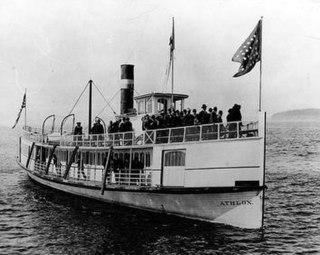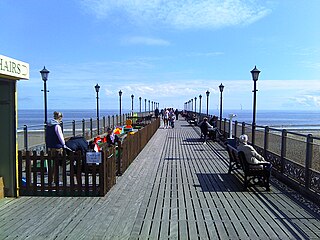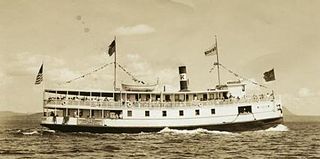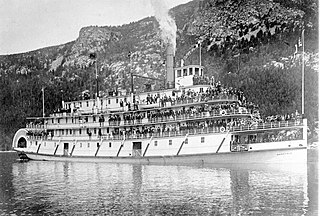
House is a steamboat term referring to the cabin structure of a steamboat. Generally the house includes every structure on steamboat built above the first deck, which is usually called the freight deck or the engine deck.

House is a steamboat term referring to the cabin structure of a steamboat. Generally the house includes every structure on steamboat built above the first deck, which is usually called the freight deck or the engine deck.

Eureka is a side-wheel paddle steamboat, built in 1890, which is now preserved at the San Francisco Maritime National Historical Park in San Francisco, California. Originally named Ukiah to commemorate the railway's recent extension into the City of Ukiah, the boat was built by the San Francisco and North Pacific Railroad Company at their Tiburon yard. Eureka has been designated a National Historic Landmark and was listed in the National Register of Historic Places on April 24, 1973.

Carpenter Gothic, also sometimes called Carpenter's Gothic or Rural Gothic, is a North American architectural style-designation for an application of Gothic Revival architectural detailing and picturesque massing applied to wooden structures built by house-carpenters. The abundance of North American timber and the carpenter-built vernacular architectures based upon it made a picturesque improvisation upon Gothic a natural evolution. Carpenter Gothic improvises upon features that were carved in stone in authentic Gothic architecture, whether original or in more scholarly revival styles; however, in the absence of the restraining influence of genuine Gothic structures, the style was freed to improvise and emphasize charm and quaintness rather than fidelity to received models. The genre received its impetus from the publication by Alexander Jackson Davis of Rural Residences and from detailed plans and elevations in publications by Andrew Jackson Downing.

The Government Bridge or Arsenal Bridge spans the Mississippi River, connecting Rock Island, Illinois and Davenport, Iowa. The Iowa Interstate Railroad uses the upper deck of the bridge for its ex-Chicago and Rock Island Railroad route between Council Bluffs, Iowa and Chicago, Illinois. The lower deck carries automobile traffic between the two cities. It is located near Upper Mississippi Mile Marker 483, adjacent to the Mississippi River Lock and Dam No. 15. The current structure is the fourth at this location. The bridges all were built with a swing section to accommodate traffic navigating the river.

The Wabash Bridge carries a single track railroad from St. Louis County to the city of St. Charles. It is positioned next to the Discovery Bridge. It is used by the freight trains of Norfolk Southern Railway.

Delta King is a 285-foot-long sternwheel steamboat (87 m) and the sister ship of Delta Queen, built in Scotland and California for the California Transportation Company's service between Sacramento and San Francisco, California. She entered service in 1927 and continued until 1940. After wartime service with the United States Navy, Delta King served as an accommodation ship at Kitimat, British Columbia in the 1950s and then returned to California for static use at Old Sacramento where she remains as a hotel, restaurant and venue.

Bonnington was a sternwheel steamboat that ran on the Arrow Lakes in British Columbia from 1911 to 1931. Bonnington and two sisterships were the largest sternwheelers ever built in British Columbia. Bonnington was partially dismantled in the 1950s, and later sank, making the vessel the largest freshwater wreck site in British Columbia.

Wide West was a steamboat that served in the Pacific Northwest of the United States. It had a reputation as a luxury boat of its days.

Athlon was a typical passenger steamboat of the Puget Sound Mosquito Fleet.

The steamboat Daily operated in the early 1900s as part of the Puget Sound Mosquito Fleet. In later years, Daily was renamed Island Princess and later Cy Peck.

The Rossland was a sternwheel steamboat that ran on the Arrow Lakes in British Columbia. It was named after Rossland, British Columbia, once a prosperous mining town in the region.

Lytton was a sternwheel steamboat that ran on the Arrow Lakes and the Columbia River in southeastern British Columbia and northeastern Washington from 1890 to 1904.

Columbia was a sternwheel steamboat that ran on the Arrow Lakes in British Columbia from 1891 to 1894. Columbia should be distinguished from the many other vessels with the same or similar names, including in particular the propeller-driven steamboat Columbia that ran on the Arrow Lakes for many years.

SS Sicamous is a large five decked sternwheeler commissioned by the Canadian Pacific Railway (CPR) and built by the Western Dry Dock and Shipbuilding Company for Okanagan Lake service between the fruit communities of Penticton, and other towns of Kelowna and Vernon, British Columbia. Launched in 1914, Sicamous ran for many years connecting rail lines and areas. The vessel operated until 1937 and is currently beached as a part of a heritage shipyard operated by the S.S. Sicamous Restoration Society in Penticton. The vessel today is operated both as a museum and events and banquet facility.

The MV Cardiff Castle is a twin screw passenger vessel, operating on the River Dart in South Devon, UK, mainly on the cruise / ferry route between Dartmouth and Totnes, but also on circular cruises from Dartmouth, for Dart Pleasure Craft Ltd.

Skegness Pier is a pleasure pier in Skegness, Lincolnshire, England. Opened in June 1881, it was at the time the fourth longest in England, originally stretching a length of 1,844 ft (562 m). When originally built, it was a T-shaped pier with a saloon/concert hall at the pier head. Steamboat trips ran from the pier to Norfolk until 1910.

The texas is a structure or section of a steamboat that includes the crew's quarters. It is located on the hurricane deck, which is also called the texas deck. This long, narrow cabin is near and may be surmounted by the pilothouse.

State of Pennsylvania was a steamboat that was built in Wilmington, Delaware in 1923, along with her identical sister ship State of Delaware. The steamboat operated on the Delaware River between her homeport of Wilmington and the cities of Chester and Philadelphia in Pennsylvania, as well as Riverview Park in Pennsville, New Jersey. Regular service on these routes was stopped in 1960. The boat foundered near her dock on the Christina River in 1970. In 1979, she was listed on the National Register of Historic Places. In 1988, the upper decks were destroyed by a deliberately set fire, and in 2005 the hull was removed and scrapped as a hazard to navigation, all without the ship being raised.

Far West was a shallow draft sternwheel steamboat plying the upper Missouri and Yellowstone Rivers in the Dakota and Montana Territories, in the years from 1870 to 1883. By being involved in historic events in the Indian Wars of the western frontier, the Far West became an iconic symbol of the shallow draft steamboat plying the upper Missouri and Yellowstone Rivers in the era before railroads dominated transport in these areas.

The Katahdin is a historic steamboat berthed on Moosehead Lake in Greenville, Maine. Built in 1914 at the Bath Iron Works, it at first served the tourist trade on the lake before being converted to a towboat hauling lumber. It was fully restored in the 1990s by the nonprofit Moosehead Maritime Museum, and is again giving tours on the lake. One of the very few surviving early lake boats in Maine, and the oldest vessel afloat built at Bath, it was listed on the National Register of Historic Places in 1978.

Nasookin was a sternwheel-driven steamboat that operated on Kootenay Lake in British Columbia from 1913 to 1947. Nasookin was one of the largest inland steam vessels ever to operate in British Columbia and the Columbia River and its tributaries. Nasookin became surplus to its original owner, the Canadian Pacific Railway, and was transferred to the British Columbia Provincial government which used it as an auto ferry until 1947. Negligent mooring of the steamer in 1948 led to irreparable damage to its hull, and it was later scrapped. Portions of the upper works were salvaged and used as a house.